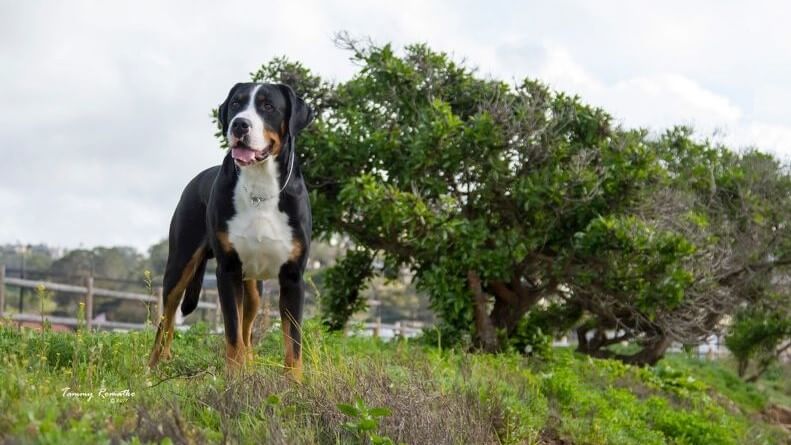
Home » History of the Greater Swiss Mountain Dog

This article was originally published in Showsight Magazine, November 2013 issue.
The ancestors of the modern-day Greater Swiss Mountain Dog are interwoven in the history of Switzerland. Easier to keep and more purposeful than the horse in mountain terrain, these dogs were critical in the daily life of the working man. They helped with the chores and workload of butchers, cattlemen, manual workers, and farmers. Drafting, droving, guarding, and working alongside their master were their primary purposes.
Tough breeding programs did not really exist at the time. Work duties selected for a big, heavy dog with a sturdy appearance, calm, steady temperament, bold and confident, yet non-aggressive and non-hunting. Coat length was largely immaterial, though the shorter, weather-resistant coat with heavy undercoat seemed to hold preference. Dogs had to be able to do the work of the day while being maintained on relatively little food, primarily leftovers from the family table. Dogs that did not make the grade in terms of temperament or working ability were typically butchered and added to the soup pot.
Color in the working dog was primarily immaterial, typically red, yellow, or black and tan, all with or without white markings. There did seem to develop a preference for red and white dogs in the late 1800s, likely due to the growing world notice of the Saint Bernard.
Before the late 1800s, the breed was a “type” rather than a breed. As the red/white Saint Bernard-type preference developed in the cities, the black-tri-colored dogs were typically left in the hands of the farmers and herdsmen, thus forming the foundation of the Bernese Mountain Dog. The long coat with its truer, more striking colors came into favor, and long coat bred to long coat produced long-coated puppies, thus forming the foundation for developing a breed.
In 1908, the 25th anniversary show of the Swiss Kennel Club saw Franz Schertenleib, a well-known Berner breeder, bring a heavy-bodied, short-coated “Bernese” to the show. He had seen this dog in a remote area, bought him as an oddity, and brought him to the show to see what well-respected judge Professor Albert Heim would say about this “short-haired Berner.” Any other judge might have dismissed this dog as undesirable for breeding, or perhaps even the development of long- and short-coated Bernese.
However, Professor Heim remembered seeing such dogs in the 1860s and declared him a marvelous example of the old-type Sennenhund breed. This led to a countrywide search for other dogs of the type to save them from extinction. The search brought forth 21 examples of the breed, and the “Grosser Schweitzer Sennenhund” (Greater Swiss Mountain Dog) was developed as an individual breed. Only 7 of those first 21 dogs registered are found in the pedigrees of the modern GSMD.
Common issues seen in the development of the breed were the lack of clear colors and the difficulty in finding quality bitches. Bitches tended to be too “fine,” and the color of the undercoat (typically tending from light gray to yellow) tended to “muddy” the black coloring, detracting from the striking black-tri-color preference. For many years, long-haired puppies would appear in breedings, a trait which is still occasionally seen today. The use of local studs and chance breedings rather than a strategic plan hampered development.
Indeed, the GSMD of the 1970s could be traced back to tight inbreeding in very few generations. Crossbreeding to Berners in the 1950s resulted in short-haired puppies with clearer colors, darker undercoats, and deeper red color. However, this also produced poor gait, bad bites, and nervousness and shyness, which led to a shift back toward purebred stock and away from crossbred “improvement.”
Development of the breed proceeded forward with an effort toward standardization. Preference was given to a harmonious combination of height, power, agility, strong muscles, and solid structure. A broad, thick body with little abdomen tuck-up and a “cow-dog” head, with a flatter top skull to distinctly distinguish it from the rounder head of the Saint Bernard, was favored. There was also a preference for a tight eyelid, slight stop, and away from heavy hanging lips. The short coat was to be rough and weather-resistant, more rough than smooth, often lacking luster.
In the words of M. Magron, “It may be less beautiful than the sparkling long coat of the Berner Sennenhund, but the GSSH is a dog for the weekdays, not for Sunday. And at the time being, we have six weekdays and but one Sunday.”
The original dogs ranged from 23½”-28″ in height, with males weighing from 83-143 lbs and females from 81.4-138 lbs. Females were typically as heavy as the males due to being longer in body and heavier in pelvis. The general ratio of length to height of the original dogs was 10:9. By 1971, males seldom reached 27″ and females seldom reached 25.8″.
Development of the breed was quite slow, with several setbacks in war-torn Europe. In 1967, there were only 46 GSMDs registered with the Swiss club. In 1968, Patricia and Frederick Hoffman of Indiana brought the first GSMD to the United States. The first 20 years of development in the U.S. were primarily done by Dr. Howard and Mrs. Gretel Summons under the kennel name Sennenhof. The Greater Swiss Mountain Dog Club of America was formed in 1971, the registry started, and the breed has since taken off. The GSMD gained full recognition in the AKC Working Group in 1995.
The development of the GSMD in the United States has been steady, and while they have modest recognition in group-level competition, the quality of the breed as a whole continues to improve. Their striking appearance, suitability as a great family pet, and general good health have endeared them with a popularity that continues to grow.